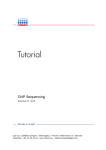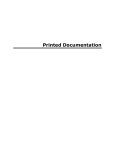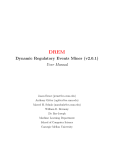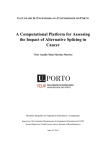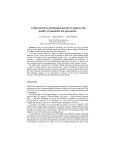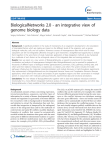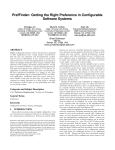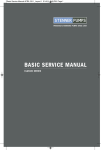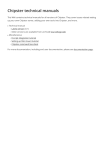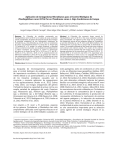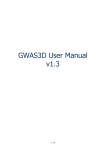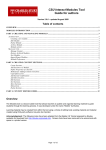Download ChIP Sequencing using Biomedical Genomics Workbench
Transcript
Tutorial ChIP Sequencing using the Biomedical Genomics Workbench November 24, 2015 Sample to Insight CLC bio, a QIAGEN Company Silkeborgvej 2 Prismet 8000 Aarhus C Denmark Telephone: +45 70 22 32 44 www.clcbio.com [email protected] ChIP Sequencing using the Biomedical Genomics Workbench 2 Tutorial ChIP Sequencing using the Biomedical Genomics Workbench This tutorial takes you through a complete ChIP sequencing workflow using the Biomedical Genomics Workbench. The tutorial makes use of the peak-shape based Transcription Factor ChIP-Seq tool present in Biomedical Genomics Workbench 2.0 and higher. ChIP-Sequencing is used to analyze the interactions of proteins with genomic DNA. After a crosslinking step that covalently links proteins and DNA, ChIP-seq uses chromatin immunoprecipitation (ChIP) to fish out the relevant pieces of genomic DNA. By subsequent massive parallel DNA sequencing and mapping to the reference genome it is possible to identify binding sites of DNA-associated proteins. It can be used to accurately map global binding sites for any protein of interest when specific antibodies are available. A natural next step for bioinformatics analysis is to extract the binding regions and perform pattern discovery to learn about any conserved binding motif in the DNA. Usually a control experiment is performed where the immuno-precipitation step is left out. This control data is typically used to correct for sequencing biases, e.g. genomic regions that are more accessible, repeated regions or copy number aberrations. For further information, see the Wikipedia entry at http://en.wikipedia.org/wiki/Chip-Seq. The workflow consists of five parts: • Importing the raw sequencing data. • Mapping the reads to a reference genome. • Calling peaks. • Visualizing the results. In this tutorial we will focus on how to run the analysis and we will not go through the technical details of how the Transcription Factor ChIP-Seq analysis is implemented. The user manual already explains the details of the algorithm. Click the Help ( ) button in the dialog (see below) to read this or go to http://clcsupport.com/clcgenomicsworkbench/current/index.php? manual=ChIP_Seq_Analysis.html. We will look at a subset of a ChIP-seq dataset for the transcription factor NRSF (Neural Restrictive Silencer Factor) on the human cell line Gm12878. Also known as REST (RE1-Silencing Transcription factor), NRSF is a transcription factor involved in the repression of neural genes in non-neuronal cells, such as the lymphoblastoid cell line Gm12878. We therefore expect NRSF ChIP-seq peaks to be associated with genes involved in neural activity. The data was collected by the Myers Lab at the HudsonAlpha Institute for Biotechnology. This dataset is well studied and has been often used to evaluate the performances of ChIP-seq algorithms [Rye et al., 2011]. In addition to the NRSF ChIP-seq dataset, we will also use a control experiment where the immuno-precipitation step is left out. In this tutorial, we will look at only a subset of the data, namely only the reads of the NRSF and control experiments mapping to human chromosome 21. Importing the raw sequencing data First, download the data set from our web site: http://download.clcbio.com/testdata/ raw_data/ChIP-seq_NRSF_chr21_bx.zip. Unzip the file somewhere on your computer (e.g. the Desktop). Start the Biomedical Genomics Workbench and import the sequencing data: ChIP Sequencing using the Biomedical Genomics Workbench 3 Tutorial File | Import ( ) | Illumina... ( ) This will bring up the dialog shown in figure 1: Figure 1: Import raw reads. When analyzing your own data, you should select the sequencing technology appropriate for your data. This dataset consists of two fastq files obtained using an Illumina sequencer, so the Illumina importer should be chosen. Select the nrsf-chr21.fastq and control-chr21.fastq files and make sure the Paired reads checkbox is not checked. The option to discard read names and quality scores are not significant in this context and can be safely set to false because of the relatively small amount of reads. Click Next, Save the imported reads list and click Finish. After a short while, the raw reads from both files have been imported. Next, import the reference genome sequence that was also included in the zip file. In this tutorial, we will use only the human chromosome 21 as reference. The reference data is provided in clc format in the files NC_000021 (Genome).clc and NC_000021 (Gene).clc, which are the genomic chromosome 21 reference sequence and the gene annotation track for chromosome 21, respectively. To import the clc files, drag and drop the files NC_000021 (Genome).clc and NC_000021 (Gene).clc into the Biomedical Genomics Workbench or use the Standard Import tool: File | Import ( ) | Standard Import ( NC_000021 (Gene).clc | Select ) | Locate "NC_000021 (Genome).clc" and ChIP Sequencing using the Biomedical Genomics Workbench 4 Tutorial Select the default option Automatic import. The Biomedical Genomics Workbench will correctly recognize that the file is in clc format (see figure 2). Figure 2: Import reference data. Use the standard importer to import the reference sequence along with the gene annotation track. Then, press Next and choose a folder where the result will be saved. You should now have the files depicted in figure 3. Figure 3: The files created after the importing step is done. Mapping the reads to the reference genome Once the data has been imported, the next step in the analysis is to map the reads to the reference genome: Toolbox | Resequencing Analysis ( ) | Map Reads to Reference ( ) The dialog shown in figure 4 allows you to choose the files containing the raw reads. Since we want to map two lists, we check the Batch option to enable the batch mode, and select the folder where the sequence lists are stored (ChIP Sequencing in figure 4)by clicking on the arrow to the right. We then press Next and check that only the two lists control-chr21 ( ( ) are selected (figure 5). ) and nrsf-chr21 Clicking Next will allow you to select a reference sequence as shown in figure 6. ChIP Sequencing using the Biomedical Genomics Workbench 5 Tutorial Figure 4: Select sequence list containing the reads. Since we want to map two lists, we choose the batch mode. Figure 5: Check that all reads are used as input for the mapping. Figure 6: Specify the reference sequences and reference masking. At the top you select NC_000021 (Genome) ( ) by clicking the Browse and select element ( ) button. You can select either single sequences or a list of sequences as reference sequences, but in this tutorial we are using only chromosome 21. Click Next and set mapping options as shown in figure 7. For ChIP-seq, we recommend stringent mapping settings. Setting the length fraction to 0.5 specifies the minimum length fraction of a read that must match the reference sequence, and setting the similarity fraction to 0.8 specifies the minimum fraction of similarity between the read and the reference sequence. The mismatch, insertion, and deletion costs are here set at 2, 3 and 3. Next, select to ignore the non-specific matches. The settings are not important for the result of this tutorial, but when you work with your own data, this may be important. For more information about the other settings, please click the Help ( ) button. ChIP Sequencing using the Biomedical Genomics Workbench 6 Tutorial Figure 7: A stringent read matching is desired for ChIP-seq. After clicking Next, the dialog shown in figure 8 now appears. Figure 8: Create report and Save. Check Create report to obtain a detailed report about the read mapping and leave Collect un-mapped reads unchecked since we are not interested in those reads. Click Finish. You can follow the progress of the mapping both in the status bar at the bottom left corner and under the Processes tab. There is also a log showing the progress. Because of the quite big reference sequence (Human chromosome 21, with a size of 47 Mbp), it may take a few minutes to map the data. ChIP Sequencing using the Biomedical Genomics Workbench 7 Tutorial Calling peaks The results of the read mapping are now used as input to the Transcription Factor ChIP-Seq tool to detect significant peaks: Toolbox | Epigenomics Analysis ( ) | Transcription Factor ChIP-Seq ( This opens a dialog where you select the nrsf-chr21 (Reads) ( Next. ) ) (see figure 9) and click Figure 9: Select the first set of mapped reads. You can now choose control-chr21 (Reads) ( ) as control data (see figure 10). You can leave the Maximum P-value for peak calling to the default value of 0.10. A smaller P-value can be specified to obtain a smaller number of high-quality peaks, while a higher P-value threshold can be set to obtain a higher number of peaks. Figure 10: Choose control data. After clicking Next you can choose the output data to be generated (see figure 11). In this tutorial, we select all the possible outputs the Transcription Factor ChIP-Seq tool can generate. Click Next, chose the folder where you want your results to be saved and click Finish. After a few minutes, the analysis will complete and the following results will appear: • nrsf-chr21 (Reads) (Peaks) ( ) the list of all called peaks. • nrsf-chr21 (Reads) (QC Report) ( ) The quality control reports. The QC report contains metrics about the quality of the ChIP-seq experiment. • nrsf-chr21 (Reads) (Peak shape filter) ( ) The peak shape filter contains the peak shape that was learned during the ChIP-seq analysis. • nrsf-chr21 (Reads) (Peak shape score) ( ) A graph track containing the peak shape score. The track shows the peak shape score for each genomic position. Before continuing the analysis or looking at the results, we recommend to look at the quality control report. The most important sections of the report are the tables containing Quality ChIP Sequencing using the Biomedical Genomics Workbench 8 Tutorial Figure 11: Select the output data to be generated. 1. Quality control for nrsf-chr21 (Reads) measures. The report nrsf-chr21 (Reads) (QC Report) ( ) will contain one table for the NRSF1.1dataset 12) and one for the control dataset (figure 13). Quality (figure measures Measure Number of reads Value Status 486,047 Very low Notes For mammalian cells, this value should be at least 10 million reads. For smaller organisms (e.g. worm and fly), this value should be at least 2 million reads Relative strand correlation 1.012 OK The relative strand correlation describes the ratio between the fragment-length peak and the read- length peak in the cross-correlation plot. This value should be greater than 0.8 for transcription factor binding sites, but can be lower for ChIP-seq input or for histone marks Normalized strand coefficient 2.488 OK The normalized strand coefficient describes the ratio between the fragment-length peak and the background cross-correlation values. This value should be greater than 1.05 for ChIP-seq experiments 1.2 Estimated Figure values 12: Table Measure of quality measures for the NRSF ChIP-seq dataset. Value Notes Length of sequenced reads For each Read of length the 3 measures, the table provides the name, 25the value, notes to better understand Estimated fragment length 90 Estimated length of the sequenced DNA fragment (excluding adaptors) the meaning of the measure and a status, which can assume the value OK if the value is reflective of sufficient quality and Low (or Very Low) if the value is lower than the quality threshold. For 3 more details on how the quality thresholds were determined, see Landt et al., 2012 and Marinov et al., 2014. In figure 12, the values for the relative strand correlation and the normalized strand coefficient are OK, while the number of reads is classified as Very Low. This should not be surprising or worrisome because the data used in this tutorial is a small subset of a ChIP-seq experiment. In fact, the full datasets consists of about 16 millions reads, which is significantly higher than the threshold value1 . However, in normal circumstances, a small number of reads would be a strong indicator that the ChIP-seq experiment is of low quality. The quality measures table for the control experiment (figure 13) can be interpreted in a similar fashion. We note that, since this is a control experiment, the value of the relative strand correlation is not important and the status would be OK also for low values. As for NRSF, the fact 1 In this tutorial, we used only the subsets of the data mapping to chromosome 21. The complete datasets can be found at the UCSC website. The complete NRSF dataset is available at http: //hgdownload-test.cse.ucsc.edu/goldenPath/hg18/encodeDCC/wgEncodeHudsonalphaChipSeq/ release1/wgEncodeHudsonalphaChipSeqRawDataRep1K562Nrsf.fastq.gz. The complete control dataset is available at http://hgdownload-test.cse.ucsc.edu/goldenPath/hg18/encodeDCC/ wgEncodeHudsonalphaChipSeq/release1/wgEncodeHudsonalphaChipSeqRawDataRep1K562Control. fastq.gz. ChIP Sequencing using the Biomedical Genomics Workbench Tutorial 9 2.1 Quality measures Measure Value Number of reads Status 307,787 Very low Notes For mammalian cells, this value should be at least 10 million reads. For smaller organisms (e.g. worm and fly), this value should be at least 2 million reads Relative strand correlation 1.192 OK The relative strand correlation describes the ratio between the fragment-length peak and the read- length peak in the cross-correlation plot. This value should be greater than 0.8 for transcription factor binding sites, but can be lower for ChIP-seq input or for histone marks Normalized strand coefficient 2.375 OK The normalized strand coefficient describes the ratio between the fragment-length peak and the background cross-correlation values. This value should be greater than 1.05 for ChIP-seq experiments Figure 13: 2.2 Estimated values Quality measures for the control ChIP-seq dataset. Measure Value Read length Notes 25 Length of sequenced reads that the number oflength reads is very low is due to the fact that101only alength small subset of the data was Estimated fragment Estimated of the sequenced DNA fragment (excluding adaptors) used. The quality report contains additional information that could be used for troubleshooting. For example, if the relative strand correlation or the normalized strand coefficient were classified as low, the cross-correlation plots should be examined5 in more details. More information regarding the cross-correlation plots and the Transcription Factor ChIP-Seq tool can be found in the user manual. Click the Help ( ) button or go to http://clcsupport.com/clcgenomicsworkbench/ current/index.php?manual=Running_ChIP_Seq_Analysis_tool.html. After having verified that the quality of the ChIP-seq datasets is acceptable, the next step is to annotate them with information about their nearest upstream and downstream genes. This can be done using the Annotate with Nearby Gene Information tool: Toolbox | Epigenomics Analysis ( ( ) ) | | Annotate with Nearby Gene Information Select first the track to annotate (nrsf-chr21 (Reads) (Peaks) ( Next, the dialog shown in figure 14 will appear: )), and after clicking Figure 14: Select the reference gene track. Choose NC_000021 (Gene) ( ) as the reference gene track, then click Next and Save the result. The file nrsf-chr21 (Reads) (Peaks) (Annotated) ( ) will be generated. You should now have the files depicted in figure 15: Visualizing the results The best way to visualize the results is to create a Genome Browser View: ChIP Sequencing using the Biomedical Genomics Workbench 10 Tutorial Figure 15: All files created after the Transcription Factor ChIP-Seq analysis is done. Toolbox | Genome Browser ( ) | Create New Genome Browser View ( ) Select the tracks we created so far as shown in figure 16 and then press Finish. Figure 16: Create a Genome Browser View to visualize the results. Once the Genome Browser View is created, the easiest way to explore peaks is to make a split view of the table and the peak annotation track by double-clicking on the label nrsf-chr21 (Reads) (Peaks) (Annotated) in the left side of the View Area. You will then be able to browse through the peaks by clicking in the table, as the peak annotation track and the table are connected (figure 17). As a result the view will jump to the position of the peak selected in the table. You can browse through all the 144 peaks found for this sample by selecting in the table. Next, we sort the table according to P-value so that we can look at the top peak (figure 17). You can sort columns by clicking on the column header, in this case the P-value. The strongest peak is close to the gene SYNJ1 (synaptojanin 1). This gene encodes a phosphoinositide phosphatase that regulates levels of membrane phosphatidylinositol-4,5-bisphosphate. The expression of this enzyme affects synaptic transmission and thus it is not a surprise that this gene is inhibited by NRSF, whose function is to repress neural genes in non-neuronal cells. Note the nicely distributed green (forward) and red (reverse) reads for this peak, this is a typical shape for transcription factors. ChIP Sequencing using the Biomedical Genomics Workbench Tutorial Figure 17: A very strong peak near the gene SYNJ1. 11 Tutorial Bibliography [Landt et al., 2012] Landt, S. G., Marinov, G. K., Kundaje, A., Kheradpour, P., Pauli, F., Batzoglou, S., Bernstein, B. E., Bickel, P., Brown, J. B., Cayting, P., Chen, Y., DeSalvo, G., Epstein, C., Fisher-Aylor, K. I., Euskirchen, G., Gerstein, M., Gertz, J., Hartemink, A. J., Hoffman, M. M., Iyer, V. R., Jung, Y. L., Karmakar, S., Kellis, M., Kharchenko, P. V., Li, Q., Liu, T., Liu, X. S., Ma, L., Milosavljevic, A., Myers, R. M., Park, P. J., Pazin, M. J., Perry, M. D., Raha, D., Reddy, T. E., Rozowsky, J., Shoresh, N., Sidow, A., Slattery, M., Stamatoyannopoulos, J. A., Tolstorukov, M. Y., White, K. P., Xi, S., Farnham, P. J., Lieb, J. D., Wold, B. J., and Snyder, M. (2012). ChIP-seq guidelines and practices of the ENCODE and modENCODE consortia. Genome Res, 22(9):1813--31. [Marinov et al., 2014] Marinov, G. K., Kundaje, A., Park, P. J., and Wold, B. J. (2014). Large-scale quality analysis of published ChIP-seq data. G3 (Bethesda), 4(2):209--23. [Rye et al., 2011] Rye, M. B., Sætrom, P., and Drabløs, F. (2011). A manually curated ChIP-seq benchmark demonstrates room for improvement in current peak-finder programs. Nucleic Acids Res, 39(4):e25. 12












